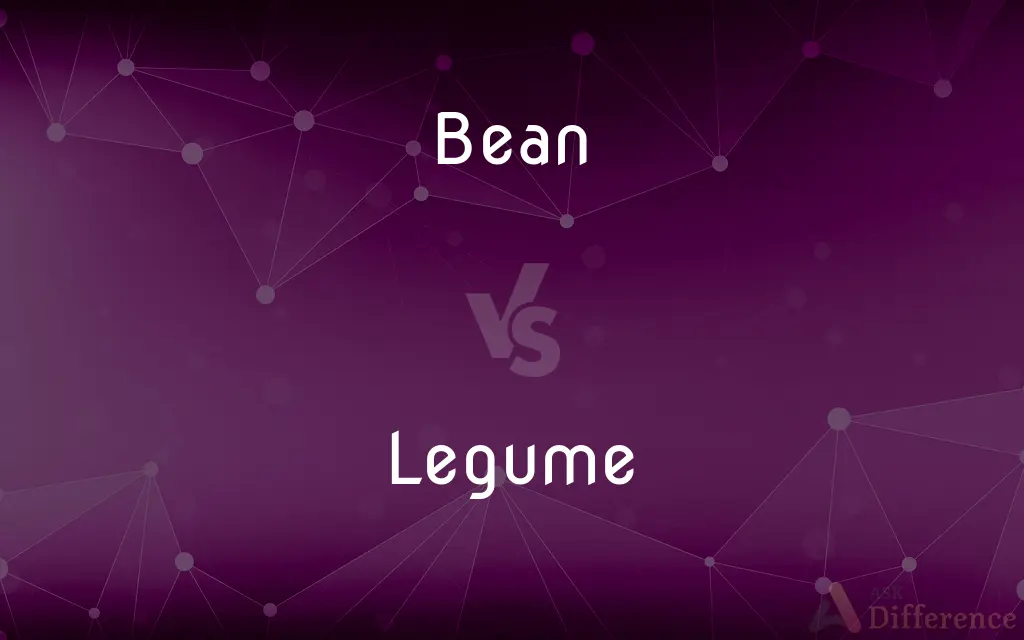Bean vs. Legume — What's the Difference?
By Urooj Arif & Fiza Rafique — Published on August 31, 2024
A bean is a type of edible seed from plants of the Fabaceae family, while a legume refers to the entire plant or the pod of plants in the same family, including beans, peas, lentils, and peanuts.

Difference Between Bean and Legume
Table of Contents
ADVERTISEMENT
Key Differences
Beans are specific types of seeds found within the pods produced by plants in the Fabaceae (or Leguminosae) family. This category includes various types, such as kidney beans, black beans, and pinto beans, known for their high protein and fiber content.
Legumes, on the other hand, encompass a broader category that includes not only the seeds (beans, peas, lentils) but also the pods and the plants themselves. The term "legume" can refer to any part of the plant, the plant as a whole, or just the seed, making it a more inclusive term than "bean."
Beans are cultivated for their seeds, which are consumed by humans and animals due to their nutritional value. Legumes, including beans, are essential in agriculture for their ability to fix nitrogen in the soil, improving soil fertility without the need for chemical fertilizers. While all beans are legumes, not all legumes are beans. For example, peanuts are legumes that are not classified as beans, despite being a type of seed.
The distinction between beans and legumes lies in their use and classification. Beans are primarily known as a food source, while legumes have broader agricultural and ecological roles. When choosing between beans and other legumes, the decision often depends on dietary preferences, nutritional needs, and culinary applications.
Comparison Chart
Definition
Edible seeds from plants of the Fabaceae family.
Refers to the plant, pod, or seeds in the Fabaceae family.
ADVERTISEMENT
Includes
Kidney beans, black beans, pinto beans, etc.
Beans, peas, lentils, peanuts, and their pods and plants.
Nutritional Value
High in protein, fiber, vitamins, and minerals.
Varies, but generally high in protein, fiber, with varying vitamins and minerals.
Agricultural Use
Cultivated for their seeds.
Cultivated for seeds, soil nitrogen fixation, and as cover crops.
Examples
Black bean, navy bean, lima bean.
Pea plants, peanut plants, lentil plants.
Compare with Definitions
Bean
A seed from certain plants in the Fabaceae family, eaten as a food source.
Black beans are often used in Mexican cuisine.
Legume
Plants, pods, or seeds in the Fabaceae family, important in agriculture and diet.
Lentils, a type of legume, are essential in Indian cuisine.
Bean
Cultivated globally for their nutritional content.
Kidney beans are a staple protein source in vegetarian diets.
Legume
Diverse in form and function, from food to cover crops.
Alfalfa, used as animal feed, is a valuable legume crop.
Bean
Consumed cooked due to the presence of toxins when raw.
Raw kidney beans contain toxins that are neutralized by boiling.
Legume
Offers ecological benefits like soil improvement.
Planting legumes is a natural way to improve garden soil fertility.
Bean
Versatile in culinary uses, from soups to salads.
Navy beans are commonly used in baked bean dishes.
Legume
Includes a wide variety of plants and their seeds.
Peanuts, although often thought of as nuts, are legumes.
Bean
Stored dry or canned for convenience.
Canned lima beans are ready to use, saving preparation time.
Legume
Used for nitrogen fixation in agriculture.
Clover, a legume, is planted to enrich soil with nitrogen.
Bean
Any of various twining herbs of the genus Phaseolus in the pea family, native to the Americas, having leaves with three leaflets and variously colored flowers, and widely cultivated for their edible pods and seeds.
Legume
A plant of the pea family.
Bean
A seed or pod of any of these plants.
Legume
A pod of such a plant, which splits into two valves with the seeds attached to one edge of the valves.
Bean
Any of several related plants or their seeds or pods, such as the adzuki bean, broad bean, or soybean.
Legume
(botany) Any of a large family (Fabaceae, syn. Leguminosae) of dicotyledonous herbs, shrubs, and trees having fruits that are legumes or loments, bearing nodules on the roots that contain nitrogen-fixing bacteria, and including important food and forage plants (as peas, beans, or clovers).
Bean
Any of various other plants or their seeds or fruits, especially those suggestive of beans such as the coffee bean or vanilla bean.
Legume
The fruit or seed of any of various bean or pea plants consisting of a two-valved case that splits along both sides when ripe and having the seeds attached to one edge of the valves
Bean
Any plant of several genera of the taxonomic family Fabaceae that produces large edible seeds or edible seedpods.
Legume
The seedpod of a leguminous plant (such as peas or beans or lentils)
Bean
The large edible seed of such a plant (for example, a broad bean, navy bean, or garbanzo bean).
Bean
A name given to the seed of certain leguminous herbs, chiefly of the genera Faba, Phaseolus, and Dolichos; also, to the herbs.
Bean
Any of various seeds or fruits suggestive of beans
Common Curiosities
Why are legumes important in agriculture?
Legumes are valued for their ability to fix atmospheric nitrogen into the soil, reducing the need for synthetic fertilizers and improving soil health.
How do legumes benefit the environment?
Beyond nitrogen fixation, legumes cover crops can prevent soil erosion, increase biodiversity, and improve soil structure.
Can you eat all types of legumes?
Most legumes are edible, but they need to be properly prepared, as some raw legumes contain toxins that can be harmful.
What is a bean?
A bean is an edible seed from various plants within the Fabaceae family, consumed worldwide for its nutritional benefits.
Are all beans legumes?
Yes, all beans are considered legumes as they are seeds of plants in the Fabaceae family.
What are some examples of legumes that are not beans?
Peas, lentils, and peanuts are examples of legumes that are not categorized as beans.
What is the nutritional value of beans?
Beans are high in protein, fiber, vitamins, and minerals, making them an excellent part of a healthy diet.
What defines a legume?
A legume can refer to the plant, the pod, or the seeds of the Fabaceae family, known for their nitrogen-fixing ability and nutritional seeds.
Are peanuts considered a bean or a legume?
Peanuts are considered a legume because they are the seeds of a leguminous plant, but they are not classified as beans.
Is there a difference in the way beans and legumes are harvested?
The harvesting method depends more on the specific plant than on whether it is classified as a bean or another type of legume.
How can I incorporate more legumes into my diet?
Legumes can be added to a variety of dishes, including soups, salads, stews, and curries, or eaten as a protein-packed snack, like roasted chickpeas.
What makes legumes a sustainable food choice?
Their nitrogen-fixing ability reduces the need for chemical fertilizers, and their protein-rich seeds provide a sustainable alternative to animal proteins.
Why are beans soaked before cooking?
Soaking beans before cooking helps to remove some of the indigestible sugars that cause gas, reduces cooking time, and can improve their texture.
How do you cook dried beans?
Dried beans should be soaked in water to reduce cooking time and improve digestibility, then boiled until tender.
Can legumes be used in crop rotation?
Yes, legumes are often used in crop rotation to naturally replenish soil nitrogen levels, enhancing the growth of subsequent crops.
Share Your Discovery

Previous Comparison
Habits vs. Behaviors
Next Comparison
Computer Monitor vs. TVAuthor Spotlight
Written by
Urooj ArifUrooj is a skilled content writer at Ask Difference, known for her exceptional ability to simplify complex topics into engaging and informative content. With a passion for research and a flair for clear, concise writing, she consistently delivers articles that resonate with our diverse audience.
Co-written by
Fiza RafiqueFiza Rafique is a skilled content writer at AskDifference.com, where she meticulously refines and enhances written pieces. Drawing from her vast editorial expertise, Fiza ensures clarity, accuracy, and precision in every article. Passionate about language, she continually seeks to elevate the quality of content for readers worldwide.













































